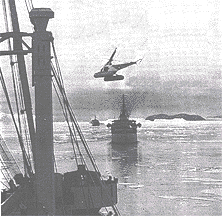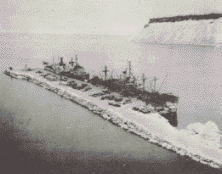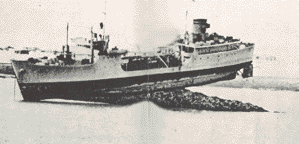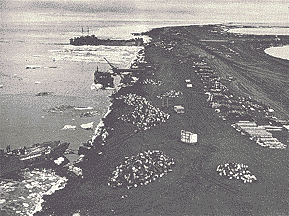To Boldly Go Where No Fleet Had Gone Before
(Military Sea Transportation Service in the Arctic)By Salvatore R. Mercogliano
The Arctic is a place of stark contrasts, an environment of unimaginable desolation, while at the same time possessing a unique beauty. Many mariners ventured into this region for profit, from harvesting whales and seals to the exploration of new trans-oceanic routes.
For the American merchant marine, this area was also the scene of one its darkest moments and perilous dangers. On July 4, 1942, Convoy PQ-17 from Iceland bound to Archangel in the Soviet Union was ordered to scatter while its naval escort beat a hasty retreat from the threat of the German super-dreadnought Tirpitz. With their defenses severed, the 33 merchantmen of the convoy, including 22 U.S.-flagged ships, fought their way through waves of U-boats, and Luftwaffe attacks to Murmansk. Only 11 of the convoy reached the USSR, and of the American ships only 8 survived.
Following this disaster, the Allies halted the resupply of Russia via the Arctic route. The tragedy drove a wedge between the navy and merchant marine, for the mariners felt abandoned by the military and the renaming of the convoys to JW did not alleviate the dread that most sailors felt when they learned they were bound for the Arctic.
Less than a decade later, ships and crews of American merchant marine once again ventured into this region. While some were veterans of the gallant PQ convoys these crews were now sailing into the northern reaches of the globe to construct a series of outposts to defend the United States from its one time ally.
Support of North Atlantic Construction and Operation Blue Jay
In late 1952, while American attention was focused on the conflict on the Korean peninsula and toward the Cold War brewing in Europe, the Military Sea Transportation Service disclosed something unique in American military history, a secret operation. As part of Operation SUNAC (Support of North Atlantic Construction) ships of the MSTS ventured into the Labrador Sea, Davis Strait, and Baffin Bay for two seasons (1951-52) to construct radar outposts along the eastern shore of Canada, and western Greenland. Of extreme importance was the enlargement of the Air Force base at Thule (Operation Blue Jay) so that it could support the new B-36 nuclear-capable strategic bombers, aptly named the "Peacemaker.
Helicopter flies ice patrol for Operation SUNACCommanded by Rear Admiral L. J. Huffman and under the direction of the first commander of MSTS, Vice Admiral Callaghan, 37 ships of MSTS, mainly time-chartered Victory ships, transported the necessary equipment while transports served as barracks for Army and Air Force engineers during the construction phase.
The location of Thule, 700 miles north of the Arctic Circle, required the ships to sail in company with icebreakers from the Canadian and American Navy and Coast Guard. Due to the heavy flow ice, ships needed to depart by early September, or face a winter trapped in the ice. The mission posed serious dangers to the crews and ships. The tanker USNS Sappa Creek experienced a radar malfunction and while in reduced visibility struck an iceberg and suffered severe damage to its bow, but was able to continue its mission.
Pier at Thule, GreenlandThe most unusual incident occurred to USNS Wacissa, one of the many small T-1 tankers operated by MSTS. The ship, operated under contract by Marine Transport Lines Inc., and commanded by Alexander McLarnon, sailed into Upper Frobisher Bay off Baffin Island during the summer of 1952. Traveling in ballast, the ship struck hard upon a reef, opening its cargo tanks and pump room to the frigid Arctic waters. The master ordered a SOS sent and the Air Force relay station on Nottingham Island informed MSTS Atlantic.
USNS Wacissa in the Arctic at low tideResponding to the stricken ship, the one-of-a-kind USNS Redbud (T-AKL 398), an ex-Coast Guard buoy tender whose original mission as a radio communication ship was a guise for its real role as an Arctic support ship, sailed for the bay to offer assistance. When the Redbud arrived, Captain Ole O. Holm witnessed a unique site. He found the entire length of Wacissa suspended out of the water on a rock outcropping, with it's stern higher than the bow and listing to port.
Unable to free the ship, Holm transferred the 35 crewmembers to his ship and awaited a salvage team to free the land-locked vessel. Forced to wait for a favorable spring tide, the Redbud eventually freed the ship after three attempts and the USS Preserver towed the ship to Nova Scotia for emergency repairs.
Operation Sealift for Security
Offloading at Point Barrow, AlaskaOperation Blue Jay and SUNAC provided MSTS with the experience to conduct its largest Arctic assault beginning in 1955. Under the command of Vice Admiral Francis C. Denebrink, who relieved Admiral Callaghan on December 20, 1952, Secretary of the Navy Thomas S. Gates ordered the service to assist in the construction of a string of radar outposts along the desolate rim of the Arctic wasteland in northern Canada. Designed to detect Soviet bombers or missiles attempting to penetrate American airspace from over the North Pole, the Distant Early Warning Line (DEW) represented a tremendous logistical and technological feat.
Previous to 1955, no large steam-driven, steel-hulled, ocean-going ship had attempted to navigate the waters east of Point Barrow, Alaska or west of Baffin Island. As early as 1576, English explorer Sir Martin Frobisher attempted to locate the elusive Northwest Passage that linked the Atlantic to the Pacific Ocean. It was not until Swedish explorer Adolf Erik Nordenskjöld in 1879 on board the Vega was the existence of the passage learned, and then lost.
Denebrink, who commanded the Pacific Fleet Service Forces during the Korean War, and was considered by naval historian Samuel Eliot Morison to be one of the unsung naval leaders of the Second World War, faced a daunting challenge.
To conduct the initial mission he divided up his 118-ship fleet into two task forces. From the west, Rear Admiral Howard L. Collins (Commander MSTS Pacific) commanded Task Force Five of 27 cargo ships, 2 tankers, 20 smaller support craft, and led by 3 icebreakers sailed eastbound around Point Barrow to deliver supplies to awaiting Canadians of the Northern Transportation Company.
In the east, Rear Admiral Redfield Mason (Commander MSTS Atlantic) commanded 31 cargo ships, 10 tankers, 4 passenger ships, 14 support vessels, and 7 icebreakers of Task Force Six.
The Western Electric Company oversaw the construction of the radar installations.
Code-named Operation Sealift for Security, for the next two seasons, ships of MSTS, the American merchant marine, and the U.S. and Canadian Navy and Coast Guard, blazed new paths into the polar regions. In 1957, under the direction of the third commander of MSTS, Vice Admiral John M. Will, the Canadian icebreaker HMCS Labrador, along with the US Coast Guard cutters Storis, Bramble, and Spar transited and charted the Northwest Passage.
The re-discovery of this passage provided an escape route for Pacific-based ships that could have been potentially trapped by the polar ice pack shifting against Point Barrow, a fact that nearly occurred in 1955 and 1956.
Ship Operations in the Arctic
Operations in the ice proved hazardous to many of the ships involved. Numerous hull punctures and shorn propeller blades kept the salvage vessels and divers of the Navy's Underwater Demolition Teams (UDT) assigned to the two task forces occupied.
To prevent further damage many of the ships underwent an "Arctization" process. This included adding a three-eighths steel doubler to the keel of MSTS operated LSTs for landings on the frozen beaches. Additionally, a nickel-aluminum-bronze alloy propeller was installed to prevent their damage when striking loose ice flows and growlers. Most of the smaller C1-M-AV1 freighters received steel sheathing along the waterline to prevent crushing damage from ice and wooden wheelhouses added to their flying bridges to protect the bridge crews from the low temperatures but still provide good visibility for maneuvering.
Ice-strengthened ship USNS AlatnaBesides the conversion of vessels, MSTS embarked on a construction program for ships specifically designed to operate in the polar environment. The first of these ships included the one of a kind cargo ship dock, the USNS Point Barrow (T-AKD 1). Resembling a Navy landing ship dock (LSD), the ship featured an icebreaker bow, an amidships ice belt, and utilized fiberglass hull insulation to protect the crew and equipment from the cold. The stern docking well allowed the ship to transport landing craft for over-the-shore discharge of cargo and small tugs for the mooring of ships.
The second class of polar-ships aimed to replace the T-1 tankers, like Wacissa. Two tankers, USNS Alatna and USNS Chattahoochee, featured the usual Arctic protection but also included a secondary pilothouse fitted on the foremast, and several cargo booms. These enabled the ships to carry deck cargo, specifically snow-cats for use on the ice and include provisions for survival gear in case the ships became trapped in the ice.
The last class aimed at replacing the C1 freighters broken out from the National Defense Reserve Fleet every season. The Mirfak, Mizar, and Eltanin were cargo versions of the Alantas, featuring many of the same features but designed to transport both dry and frozen cargo to resupply the many DEW stations.
In 1958, the Distant Early Warning Line went into full operation. MSTS operations into the Arctic opened the entire Northern Alaska and Western Canadian shoreline to commercial shipping. To provision the Canadian stations, MSTS transferred three tankers and three LSTs to the US Air Force, who in turn leased them to the Canadian-owned Northern Transportation Company, Limited. In 1960 Canada assumed the mission of resupplying the eastern Canadian "Gap Pine" bases, leaving MSTS only Thule and Goose Bay.
In 1965, MSTS was reassigned the mission of maintaining the DEW Line stations. Instead of mounting a huge fleet of nucleus and MARAD-activated ships, which would have taken away from the supply of the Vietnam War, the service adopted the method utilized by the Canadians -- tugs and barges.
MSTS contracted the Alaska, Puget United Transportation Company, a joint venture of the Alaska Barge and Transport Company, and Puget United Transportation Company, along with the McGrath and Kuskokwim Freight Services Inc. To accomplish this task, four tugboats, along with a fleet of barges, including one converted from an old LST, were utilized to provide supplies, fuel, and equipment to thirty-five stations.
'Fuel Barge"
While the DEW Line is no longer in existence, the Military Sealift Command (MSC, successor to MSTS) continues the resupply of Departments of Defense, Transportation, and Interior stations in Alaska under the name "Fuel Barge."
Today fleets of ships no longer sail along the west coast of Greenland. In July 1999, two MSC ships, the tanker MV Gus Darnell and the freighter MV Green Wave, escorted by the Canadian Coast Guard icebreaker Henry Larsen performed the replenishment of the base at Thule. Three ships are a stark contrast to the fleets of over one hundred vessels that ventured into the Arctic in the mid-1950s. The Darnell transported the fuel equivalent of seven-and-a-half Wacissas.
The use of air transportation during the spring and fall, and the diminishing of the U.S. military presence overseas has alleviated a portion of the supply requirements, but the increase in the capabilities of merchant ships makes each exponentially more productive than their World War Two built predecessors.
MSTS Success in the Arctic
Military Sea Transportation Service's success in the Arctic is one of the most unsung successes of the Cold War and maritime history. Admiral Will summarized MSTS support for the DEW Line, "Operating in some of the world's severest weather in one of the last of the legendary frontiers, men from diverse military and civilian agencies are engaged in sealifting the material that will fashion the defense screen that can provide the advance warning which may very well save millions of lives."
Over the three years, MSTS transported nearly a million measurement tons of cargo and ten million barrels of petroleum products. Admiral Will leveled his greatest acclaim on the 12,000 "Bluenose" mariners for their service on board American merchant ships and MSTS nucleus fleet vessels. For his management of the undertaking, Will was promoted to the rank of four-star admiral, the only commander of the Military Sea Transportation Service or Military Sealift Command to reach this lofty goal and a direct reflection on the importance of Operation Sealift for Security to the nation.
Illustrations from:
Military Sea Transportation and Shipping Control, NAVPERS 10829-A, Bureau of Naval Personnel, Washington, DC: U.S. Government Printing Office, 1954
Military Sea Transportation Service, NAVPERS 10829-B, Bureau of Naval Personnel, Washington, DC: U.S. Government Printing Office, 1962
Sealift, October 1969, Military Sea Transportation Service, U.S. Government Printing Office, 1969
www.USMM.org is grateful to Professor Salvatore R. Mercogliano for providing this article. Mercogliano is writing his doctoral dissertation about the history of the Merchant Marine, Military Sea Transportation Service and Military Sealift Command.Tankers: Fuel for Thought by Salvatore R. Mercogliano
Special Missions of MSTS and MSC by Salvatore R. Mercogliano
MSC Ships that Wait by Salvatore R. Mercogliano
MSC Ships of the Line by Salvatore R. Mercogliano
MSTS and MSC Operations Other Than War by Salvatore R. Mercogliano
Home11/29/00
www.USMM.org ©1998, 1999, 2000 Salvatore R. Mercogliano and. You may quote material on this web page as long as you cite American Merchant Marine at War, www.usmm.org, as the source. You may not use more than a few lines without permission. If you see substantial portions of this page on the Internet or in published material please notify usmm.org @ comcast.net




